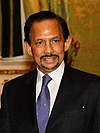
A | B | C | D | E | F | G | H | CH | I | J | K | L | M | N | O | P | Q | R | S | T | U | V | W | X | Y | Z | 0 | 1 | 2 | 3 | 4 | 5 | 6 | 7 | 8 | 9
This article needs additional citations for verification. (June 2022) |

There are several monarchies in Asia, while some states function as absolute monarchies where the king has complete authority over the state, others are constitutional monarchies where a monarch exercises authority in accordance with a constitution and is not alone in decision making.[1]
National monarchies
Constituent monarchies
United Arab Emirates
The United Arab Emirates consists of seven emirates that are all ruled by absolute monarchs. The President of the United Arab Emirates is an office held by the Ruler of Abu Dhabi and the office of Prime Minister is held by the Ruler of Dubai. The seven Emirates of the UAE are:
- Emirate of Abu Dhabi
- Emirate of Ajman
- Emirate of Dubai
- Emirate of Fujairah
- Emirate of Ras al-Khaimah
- Emirate of Sharjah
- Emirate of Umm al-Quwain
Gallery
Note: Sheikh Humaid bin Rashid Al Nuaimi of Ajman, Saud bin Rashid Al Mu'alla of Umm al-Quwain, Saud bin Saqr Al-Qasimi of Ras al-Khaimah, and Hamad bin Mohammed Al Sharqi of Fujairah are not pictured.
Malaysia
Malaysia, where the Yang di-Pertuan Agong (Supreme Head of State) is elected to a five-year term. Nine hereditary rulers from the Malay States form a Council of Rulers who will determine the next Agong via a secret ballot. The position has to date, been de facto rotated through the State rulers, originally based on seniority. The nine Malay States are the;
- Negeri Sembilan
- Perlis Indera Kayangan
- Sultanate of Selangor
- Sultanate of Terengganu
- Sultanate of Kedah
- Sultanate of Kelantan
- Sultanate of Pahang
- Sultanate of Johor
- Sultanate of Perak
The monarchy of Negeri Sembilan is itself elective.
Other subnational
India and Pakistan
The British ruled Indian Empire became independent from British rule in 1947 and became the Dominion of India and the Dominion of Pakistan and in 1950 India became the Republic of India, in 1956 Pakistan became the Islamic Republic of Pakistan, and in 1971 the province of East Pakistan separated from Pakistan to become Bangladesh. Princely states were only in the present-day countries of India and Pakistan, and not Bangladesh. The princely states who were vassal states of the British, had a certain degree of power and autonomy during the British Raj. The princely states had integrated into the newly independent India and Pakistan between 1947 and 1975 (the majority of states ascended into India or Pakistan in 1948) and the former monarchs of the princely states who joined before 1971 in India and before 1972 in Pakistan became titular rulers that received a privy purse and initially retained their statuses, privileges, and autonomy. During this time, the former princely states in India were merged into unions, each of which was headed by a former ruling prince with the title of Rajpramukh (ruling chief), equivalent to a state governor.[2]
In 1956, the position of Rajpramukh was abolished and the federations dissolved, the former principalities becoming part of Indian states. The states which acceded to Pakistan retained their status until the promulgation of a new constitution in 1956, when most became part of the province of West Pakistan; a few of the former states retained their autonomy until 1969 when they were fully integrated into Pakistan. The Indian Government formally derecognised the princely families in 1971, followed by the Pakistani Government in 1972, in which their titles, autonomy, and privy purses were take away. Presently the rulers of the former princely states are pretenders who carry out ceremonial roles.
List of Princely States
| Name | Capital | Salute type | Existed | Location/ Successor state |
|---|---|---|---|---|
| Ajaigarh State | Ajaygarh (Ajaigarh) | 11-gun salute state | 1765–1949 | India |
| Akkalkot State | Ak(k)alkot | non-salute state | 1708–1948 | India |
| Alipura State | non-salute state | 1757–1950 | India | |
| Alirajpur State | (Ali)Rajpur | 11-gun salute state | 1437–1948 | India |
| Alwar State | 15-gun salute state | 1296–1949 | India | |
| Amb (Tanawal) | Darband/ Summer capital: Shergarh | non-salute state | 18th century–1969 | Pakistan |
| Ambliara State | non-salute state | 1619–1943 | India | |
| Athgarh | non-salute state | 1178–1949 | India | |
| Athmallik State | non-salute state | 1874–1948 | India | |
| Aundh State | Aundh (District - Satara) | non-salute state | 1699–1948 | India |
| Babariawad | non-salute state | India | ||
| Baghal State | non-salute state | c.1643–1948 | India | |
| Baghat | non-salute state | c.1500–1948 | India | |
| Bahawalpur (princely state) | Bahawalpur | 17-gun salute state | 1802–1955 | Pakistan |
| Balasinor State | 9-gun salute state | 1758–1948 | India | |
| Ballabhgarh | non-salute, annexed by the British Raj | 1710–1867 | India | |
| Bamra | non-salute state | 1545–1948 | India | |
| Banganapalle State | 9-gun salute state | 1665–1948 | India | |
| Bansda State | 9-gun salute state | 1781–1948 | India | |
| Banswara State | 15-gun salute state | 1527–1949 | India | |
| Bantva Manavadar | non-salute state | 1733–1947 | India | |
| Baoni State | 11-gun salute state | 1784–1948 | India | |
| Baraundha | 9-gun salute state | 1549–1950 | India | |
| Baria State | 9-gun salute state | 1524–1948 | India | |
| Baroda State | Baroda | 21-gun salute state | 1721–1949 | India |
| Barwani State | Barwani (Sidhanagar c.1640) | 11-gun salute state | 836–1948 | India |
| Bashahr | non-salute state | 1412–1948 | India | |
| Basoda State | non-salute state | 1753–1947 | India | |
| Bastar state | non-salute state | 1324–1948 | India | |
| Baudh State | non-salute state | 1874–1948 | India | |
| Beja State | non-salute state | 18th century–1948 | India | |
| Benares State | 13-gun salute state | 18th century–1948 | India | |
| Beri State | non-salute state | c.1750–1950 | India | |
| Bhaisunda | non-salute state | 1812–1948 | India | |
| Bhajji State | non-salute state | late 18th century–1948 | India | |
| Bharatpur State | 17-gun salute state | 17th century–1947 | India | |
| Bhavnagar State | 13-gun salute state | 1723–1948 | India | |
| Bhopal State | Bhopal | 19-gun salute state | 1707–1949 | India |
| Bhor State | 9-gun salute state | 1697–1948 | India | |
| Bijawar State | 11-gun salute state | 1765–1950 | India | |
| Bikaner State | 17-gun salute state | 1465–1947 | India | |
| Bonai | non-salute state | 12th century–1948 | India | |
| Bundi State | 17-gun salute state | 1342–1949 | India | |
| Cambay State | 11-gun salute state | 1730–1948 | India | |
| Nawab of the Carnatic | non-salute, annexed by the British Raj | c.1690–1801 | India | |
| Chamba State | Chamba | 11-gun salute state | c.550–1948 | India |
| Changbhakar (Chang Bhakar) | non-salute state | c.1790–1948 | India | |
| Charkhari State | 11-gun salute state | 1765–1950 | India | |
| Chaube Jagirs | non-salute state | 1812–1948 | India | |
| Chhatarpur State | 11-gun salute state | 1785–1950 | India | |
| Chhota Udaipur State | 9-gun salute state | 1743–1948 | India | |
| Chhuikhadan State | non-salute state | 1750–1948 | India | |
| Chitral (princely state) | Chitral | 11-gun salute state | 1560–1969 | Pakistan |
| Chota Nagpur States | non-salute state | 12th century–1948 | India | |
| Chuda | non-salute state | India | ||
| Cooch Behar State | 13-gun salute state | 1586–1949 | India | |
| Cutch State | 17-gun salute state | 1147–1948 | India | |
| Danta State | 9-gun salute state | 1061–1948 | India | |
| Darkoti | non-salute state | 11th century–1948 | India | |
| Daspalla State | non-salute state | 1498–1948 | India | |
| Datarpur | non-salute, annexed by the British Raj | c.1550–1849 | India | |
| Datia State | 15-gun salute state | 1626–1950 | India | |
| Dewas State | 15-gun salute state | 1728–1948 | Zdroj:https://en.wikipedia.org?pojem=Monarchies_in_Asia
















